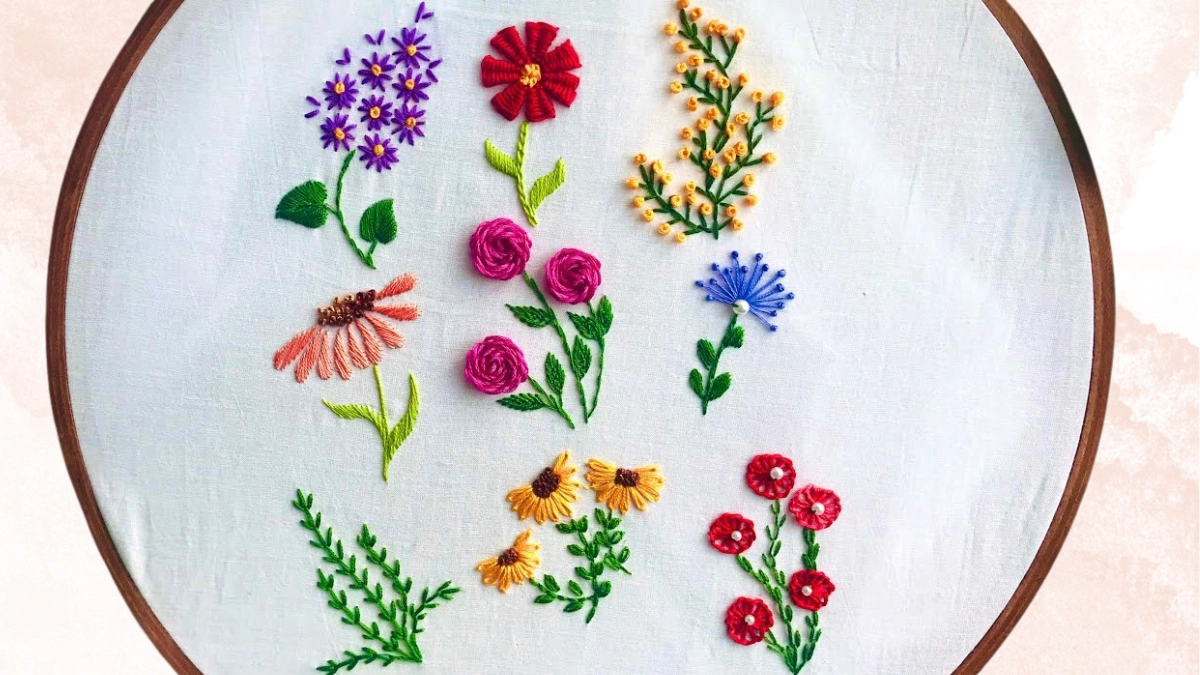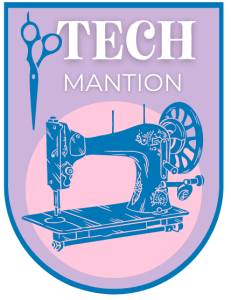Don’t just stick to satin or chain stitch, upgrade your skills and learn couching stitch to create fancier designs on different fabrics.
Couching is not an embroidery, but rather a process or a theory as there are many thick and thin details, types, and certainties you should know about to create it.
Don’t worry! In this blog, I’ll cover those all under one roof including hand couching, surface couching, machine couching, and so forth. Let’s begin!
Table of Contents
Importance of Couching Stitch

If you are an entrepreneur, this is not just a post but an opportunity to learn the couching and grow your business more. It would be right to say that couching is every customer’s favorite embroidery for many obvious reasons. In my opinion, it is most trendy for its versatility as you can make up various designs like flowers, borders, lines, motifs, and whatnot using the couching. But, this beautiful embroidery is not a startup thing, you have to learn basic stitches before it.
What Is Couching Stitch?
The couching stitch is not an embroidery technique but a process to enhance the splendor, standard, and beauty of any fabric. It consists of the thread that holds the surface thread in a place like a symbiotic relationship.

You can follow multiple patterns using couching like straight lines, zigzags, flowers, shapes, and other structures. It is suitable for all monograms to textured fabrics; however, I usually do couching embroidery on solid fabrics in pastel colors so that my work pops out instead of the fabric design.
Like I said earlier, couching embroidery is the game of two threads; one is called surface thread or fabric thread while the other one is embroidery thread or the one you’re using for couching. The surface thread can be textured, thick, or of different styles because it does not play a major role. Conversely, the couching thread is of great concern so it should be chosen wisely. Shortly, the yarn thread is most adaptive for couching for its evenness.
What Is Hand Couching?
Couching is differently categorized based on its application, and among all one of the most common terms used in the industry is hand couching. The hand-couching and laid-work embroidery are synonymous with each other, and both of these refer to the technique involving stitching of the fabric thread. In history, hand couching was the only thing that existed and was extensively used for designing cushions and bed covers. Later on, the same technique evolved to other forms.
Hand couching, in a nutshell, is couching done by hand instead of something electronic. But when couching evolved and got popular in the market, machines were introduced to serve the purpose. While that doesn’t mean the extinction of hand couching, as the thing still exists in various parts of the world and has its own recognition. For your information, hand-couching embroidered fabrics or items are more expensive than the ones woven by machine.
What Is Surface Couching?

Surface couching is the term used to define the basic couching that is done in a way that the fabric thread pops out too in the end result. This is why it greatly depends on the surface fabric like linen, cotton, velvet, and so forth. Among all, cotton is the approved and extensively used fabric for surface couching. You can also use other fabrics with a bit thicker thread as a substitute. Surface couching is mostly used to create outlines, borders, and stems on the edges of bedcovers, curtains, cushions, napkins, and more.
Materials You Need To Embroider Couching Stitch
To embroider a couching stitch, you’ll need a couple of materials like a needle, embroidery floss, embroidery hoop, fabric, and more. At the first point, please get yourself an excellent quality needle with a giant eye to make couching embroidery on your favorite fabrics. The needles designed for the couching embroidery are also called tapestry needles, and these are available at almost all sewing stores.
Secondly, you need to have embroidery floss. Let me clear one thing, floss is not an optional product, especially when you are making money out of the embroidery or running a reputable brand. This is because the embroidery floss, purposely, hides the securing threads and improves the final look of your entire work. In my suggestion, please always opt for two distinct and vibrantly different shades of threads for couching as this also helps the floss function perfectly and results in a well-contrasted embroidery.
In the end, you need an embroidery hoop for couching. The hoop, as the name implies, holds the fabric or substrate and helps you do your work without any hassle. It secures the fabric in one place and will not let it move to the other until you want it to, isn’t it so helpful? You can move the embroidery loop around as per your requirement in the entire process.
Now that we are discussing the materials needed for couching, it is a good time to highlight some important queries here. Which needle is best for couching stitch?—is the most frequently asked question by most embroiderers. Like I said earlier, you need a tapestry needle for the couching embroidery. The tapestry needle is the one with a giant eye, so if it is not available at your place, try looking for a substitute needle with a bigger eye than regular needles to do couching embroidery.
Which fabric is best for couching stitch?—is another popular query. Couching is the process of sewing fabrics or threads together, so the fabric should be woven with a thick and high-quality thread that won’t break in the midst of the process. One more thing that you should know is to choose the color of the fabric in contrast with the thread’s shade, as it will help you throughout the process and will look well-contrasted, vibrant, and vivid in the end.
Step-By-Step Guide To Embroider Couching Stitch
In the couching embroidery, step one is to mark the structures, so that it would be easier for you to trace them without making mistakes. You can sketch any of your favorite designs. If you’re a beginner, try out some basic designs first and gradually move toward the complex ones. You can search web pages or applications like Pinterest to find trendy couching designs. Take a printout of the selected design and place a fabric onto it for easier marking.
After drawing the design onto the fabric, set the embroidery hoop. As I said earlier, the hoop is a non-skippable thing to embroider couching like a pro. The hoop basically holds the surface thread in a uniform position, avoiding wobbling or unwanted movements to make your work smoother, time-saving, and effort-saving. Not only that, but the hoop also helps you in moving to the next fabric thread without any difficulty.
It is recommended to thread needles with contrast colors like yellow and red, white and black, baby pink and purple, and so forth. The key is to choose one darker shade and one lighter tone shade. However, if you’re an entrepreneur, you can’t choose colors as per your choice, you have to consider what the customer wants regardless of what is easier for you. In my opinion, the color shades have directly nothing to do with the end results if you are a pro at couching.
In the next step, you need to take the surface thread up from the fabric towards the initial point of the couching embroidery. You can use dual strands if the surface thread is thin, while if you have already chosen the thick yarn fabric, you can go with the single strand. Now start the couch stitching and move the thread to pin it. Please make sure to be as gentle and firm as you can to get the best results. Continue to couch the thread along the traced design until the endpoint.
No hurry embroiderers! You can complete your work in intervals too, so please do couching gently and uniformly at your ease. It’s better to take your time and complete work nicely instead of ruining the results and wasting time, effort, and essentials.
What Is Machine Couching?
When couching embroidery turned the tables and its demand in the market increased, machine couching was introduced. As the name implies, it refers to the same couching process that we discussed above, but the only difference is the machine used instead of the hand. You cannot do couching with the conventional sewing machine, there are specialized couching machines that are compatible with different needles and threads and do couching embroidery in minutes.

If you’re an entrepreneur and have money to invest, you should buy the couching machine to save the cost of labor, time, and additional effort. Machine couching is way too easy than hand couching and gives appreciable results. The best thing about machine couching is that it lets you use different kinds of threads and fabrics and couch beautiful designs like strands, flowers, borders, and many more.
But, the best quality couching machine is a must-have thing to get all these benefits. The market is flooded with a range of couching machines, while I have strong faith in Brother’s machines only for their excellent quality, reputation, warranty policies, and performance. Once you have the best couching machine, you’ll have to select the right thread and fabrics to get the desired results. Don’t sweat it out! You’ll find extensive literature on it on the web, as well as, the machine manuals include details on that.
If you want to checkout some Best embroidery machines then feel free to read our expert reviews.
Step-By-Step Guide To Machine Couching
In the first step, you need to choose the stands of the floss. Like the hand couching, the contrasting color threads will help you in the process, while if you are an entrepreneur, make sure to stick to the customer demands. Thread the couching machine by inserting the threads into the needle and you’re done. If you’re a noob, please see the detailed instructions provided in the manual of your machine to avoid any mistakes.
In the next step, you need to secure the embroidery floss. There is no rocket science, all you need to do is to slide the floss a bit below the thread bar under the machine foot and you’re done. Please make sure that it is secured rightly and that at least one inch of floss is beside the foot.
Now that you’re done with the machine setting, place the fabric under the foot and choose the stitch from the options. Please adjust the stitch width and other options from the settings correctly. Again, if you’re not aware, seek help from the instruction manual provided by the manufacturer. You will not need this step every time, once you have set the settings, it will remain the same until you next change it.
Machine couching, in a nutshell, is an effortless and time-saving version of hand couching. However, it costs you more as the couching machines are no less than a thousand dollars. If you’re not budget-conscious, go for machine couching, otherwise, learn hand couching.
What Is Needlepoint Couching?
Another term used in the marker is called needlepoint couching, so I decided to add a quick tour to it too. The needlepoint couching refers to fixing thread to the needlepoint substrate i.e., canvas. In contrast to the regular stitches, the needlepoint couching is done on the canvas. It is a simple process that is used to create artistic designs on canvas of different sizes, shapes, and colors.
There are many reasons to learn needlepoint couching. It is used to make even and smooth designs like curves, lines, zigzag patterns, and more. It is used to create designs on canvases and add texture to them. Needlepoint couching is also a broadly accepted technique and is considered the best idea for startups.
In my opinion, needlepoint couching is best suited for designing letters, objects, curves, and other structures. You can easily trace the designs of your choice on canvases. I usually trace canvas using the printout of my design.
Couching A Quilt
Like I said before couching is not just an embroidery technique, its rather a theory or a process that has evolved greatly over the years around the world. Couching a quilt is another common phrase that you should know about, especially when you enter the era of embroidery as an entrepreneur. Let’s not waste time and come to the main point.
Couching a quilt is similar to standard couching but the thing which pops out differently here is the thread. In this process, you cannot use a standard thread, but a good quality yarn is used for couching. The yarn is comparatively thicker in diameter than the normal thread and is easily available in different qualities, sizes, and colors.
Another point to be noted about couching a quilt is that you can weave the yarn using your hand, especially the thicker one. A special kind of needle is usually used for yarn couching, and it is usually done by the machine. In the market, different types of yarns are there, but I prefer velvet yarns for their premium look.
Advantages Of Couching Stitch Embroidery
There are many perks of couching embroidery but predominantly it just embellishes different kinds of fabrics. Unlike other embroidery stitches, the couching doesn’t penetrate into the cotton or any other substrate nor it will destroy the fabric, it just weaves through the surface thread and turns into beautiful designs. The couching is versatile and lets you create a lot of designs like flowers, motifs, leaves, stems, and more.
Disadvantages Of Couching Stitch Embroidery
Undoubtedly, the couching is a widely accepted embroidery stitch that can be used to turn out your fabrics into beautifully designed items. But, it is not the best pick to start your embroidery career. In other words, if you are a noob and know nothing about embroidery, the couching is not something for you. You should learn basic stitches first like chain stitch, satin stitch, etc., and after that, you can gradually come to the couching embroidery.
FAQs on Couching Stitch
What is couching stitch used for?
The couching stitch is not an embroidery technique but a process to enhance the splendor, standard, and beauty of any fabric. It consists of the thread that holds the surface thread in a place like a symbiotic relationship. You can follow multiple patterns using couching like straight lines, zigzags, flowers, shapes, and other structures. It is suitable for all monograms to textured fabrics; however, I usually do couching embroidery on solid fabrics in pastel colors so that my work pops out instead of the fabric design.
What is couching in needlepoint?
In simple words, needlepoint couching is couching on canvas. The needlepoint couching refers to fixing thread to the needlepoint substrate i.e., canvas. In contrast to the regular stitches, the needlepoint couching is done on the canvas. It is a simple process that is used to create artistic designs on canvas of different sizes, shapes, and colors.
How far apart should couching stitches be?
The couching or laid couching consists of two stitches mainly making a series of thread couched to the surface. The distance between the two stitches impacts the overall end result, therefore you should take that into account that. Please don’t take the distance too far or too short between the strands of thread. Ideally, the couching stitches should be 3 to 5 millimeters apart from each other. Realistically, it is not possible to keep the exact same millimeters, but try to maintain equal difference.
Can you use a sewing machine to couch it?
Yes! Machine couching refers to the process in which a machine is used to couch instead of a hand. You cannot do couching with the conventional sewing machine, there are specialized couching machines that are compatible with different needles and threads and do couching embroidery in minutes. The best thing about machine couching is that it lets you use different kinds of threads and fabrics and couch beautiful designs like strands, flowers, borders, and many more.
What is couching in quilting?
Couching quilt refers to the standard couching process but the only difference here is the thread. A yarn is used instead of thread to quilt a fabric through couching process. The change of thread eventually causes a major difference in the overall effect and result of couching process. This is because the yarn is thicker in diameter than regular thread and it cannot be easily handled by the hand, especially if you are using a larger yarn.
How do you finish a couching stitch?
To finish a Couching Stitch in hand embroidery, you will need to secure the working threads in place. Here’s one way to do it:
- Gently pull the working threads to the back of the fabric and tie a knot with the two threads.
- Take a needle with a contrasting color thread and stitch over the knot several times to secure it in place.
- Trim the ends of the threads close to the fabric.
This method will ensure that your couching stitch remains secure and the knot will not come undone over time.
The Bottom Line
You can create geometric shapes, patterns, designs, and structures using the couching stitch effortlessly. Couching stitch is not a technique but a process to embellish any fabric. It is suitable for all monograms to textured fabrics; however, I usually do couching embroidery on solid fabrics in pastel colors so that my work pops out instead of the fabric design.
There are many types and terms of couching like hand couching, machine couching, canvas couching, couching a quilt, and more. For your assistance, I have compiled all the information under one roof. I hope you’ll find this blog useful and will become a pro embroiderer soon.









